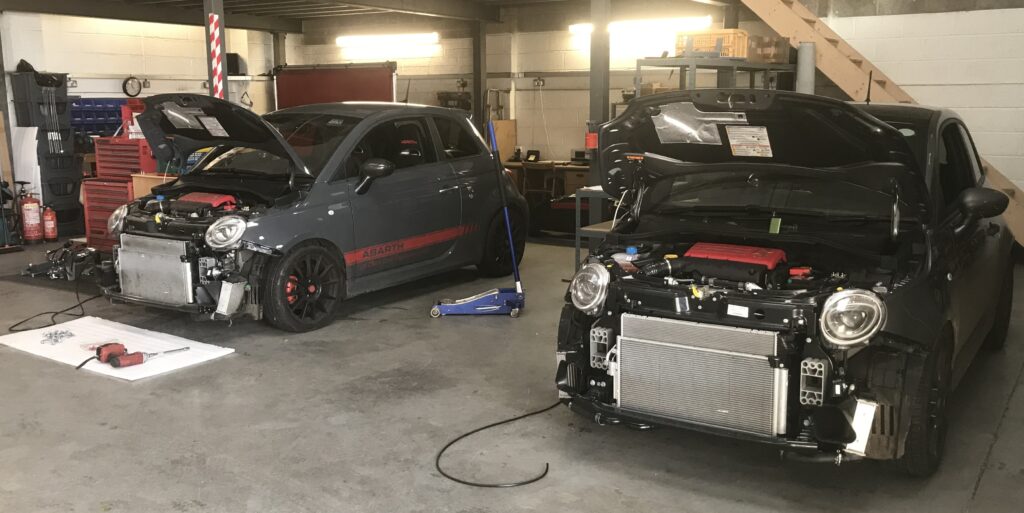
| The CAR–A-TOW system. |
| Braking System The braking system operates from an AL-KO ‘overrun’ type coupling on the towing frame. As the motorhome slows, a gas-damped piston, at the front of the coupling, operates a lever under the frame. This lever pulls on a link cable which is attached (with a removable pin) to a permanently fitted brake cable on the car. The brake cable is routed through the front area of the car, bolted through the bulkhead and attached to the brake pedal. The harder the motorhome brakes, the harder the cable will apply the towed car’s brakes. https://www.youtube.com/watch?v=9WPvpbSlJ4c Vehicle Steering How the steering allows the car to follow is really quite simple, it is the caster angle. In simple terms, the vertical spindle of the front wheels is set behind the horizontal spindle. Picture the front swiveling wheels of a child’s buggy. As the frame of the buggy is steered by the handles the front wheels swivel on their vertical spindles and follow the frame. The principle is the same on a car being towed, the body of the car follows the tow ball and the front wheels swivel on their vertical spindles and follow the body. it is necessary for the steering lock on the towed car to be set in the accessory position, this will allow the steering to turn. Don’t worry it does work! There are no attachments to the car’s steering system. Please note: It is the owner’s responsibility to establish the suitability of the steering system for flat towing. Power steering is not a problem; it can be an advantage as it creates a steering damping effect. Extreme care must be taken if your car has “Keyless Ignition”. Please talk to us at CAR-A-TOW before purchasing a car with this option. Tow Ball & Electrics The towing vehicle requires a 50mm tow ball, set at around 16″ to 18″ from the ground. A standard 7-pin (12N) lighting socket is also required; the 7-pin socket should be mounted within 6″ of the tow ball. When the towing frame is attached to the car and the motorhome, and plugged in, the required lighting on the car is powered by the motorhome. Number Plate CAR-A-TOW kits include a pair of stainless steel number plate clips. Customers are required to supply their own number plate showing the correct registration number of the towing vehicle. Clean, quick, and easy to use. Drive the car up to the rear of the motorhome Lay the towing frame in front of the car and open the folding arms Remove the protective caps from the ends of the pull-bar Close the arms of the frame over the end of the pull-bar and fit the locking pins Connect brake cable with locking pin and plug in lighting cable Drive or pull car forward to connect the frame to the motorhome tow-ball Plug the lighting cable into the socket on the motorhome and secure the safety break-away cable Go to the rear of the car and spring clip the motorhome number plate over the car number plate Sit in the driving seat and carry out the simple checks, key adjustments and attach pedal spring assister fully detailed in the ‘Frame Attachment Procedure’ supplied with the system Now the final safety check�. and you’re ready to go Braked or Unbraked There is still a great deal of misunderstanding about braked or unbraked. We can assure you the following is correct. If a trailer is fitted with brakes, they must work – it’s that simple, of course a car has brakes and if that car is being operated as a trailer they must work, regardless of its kerb weight or MAM(laden weight), forget the 750kg, it is not relevant to a car being towed as a trailer. You can only tow a car with a Braked Towing Frame System, regardless of it’s weight. Automatic transmission Cars with automatic transmission are generally not suitable for flat towing, however some cars with electronically controlled “automatic” gearboxes may be suitable. Also, some 4×4 automatics, with transfer box and free wheel hubs are suitable for towing. Please Note: It is the owner’s responsibility to establish the suitability of the transmission for flat towing. |